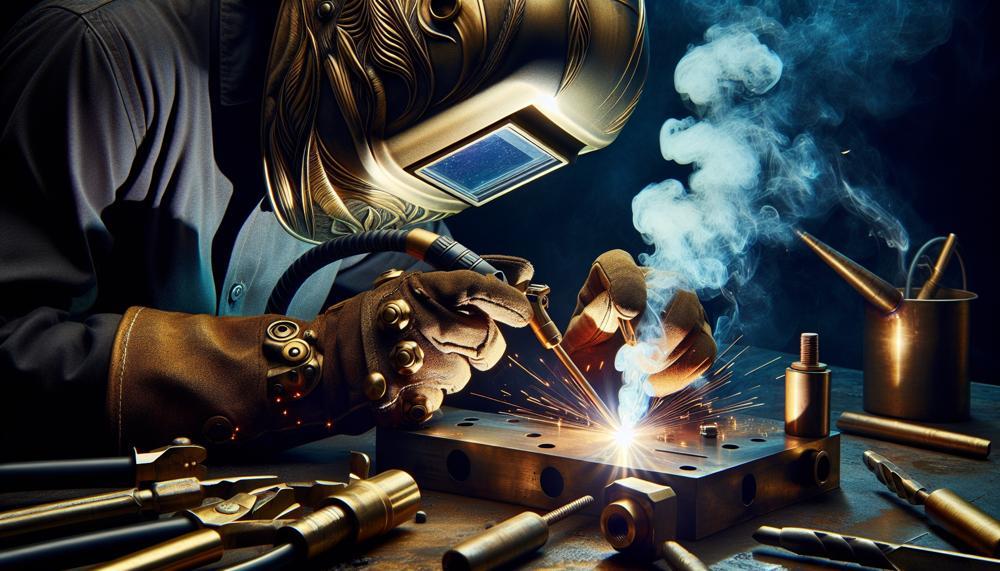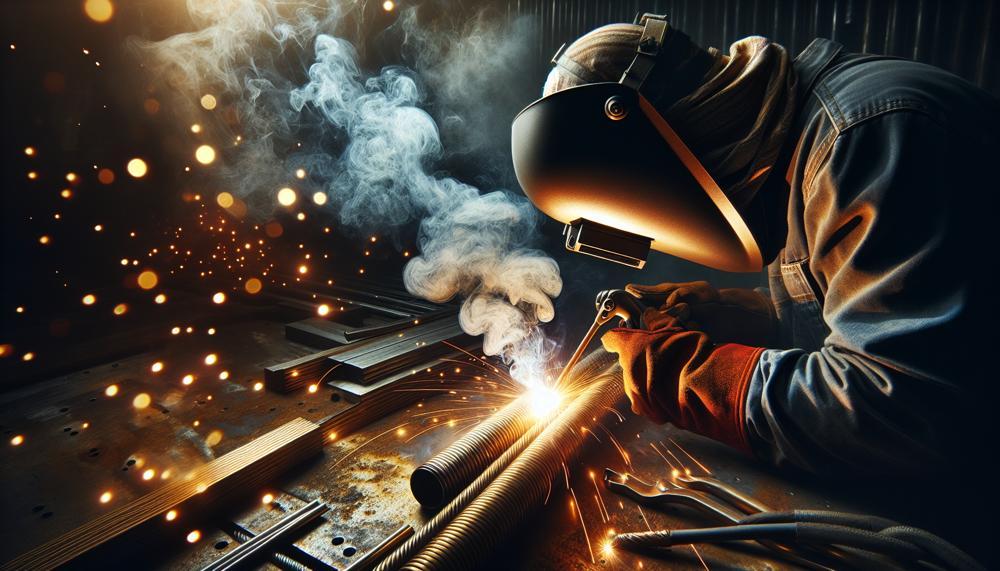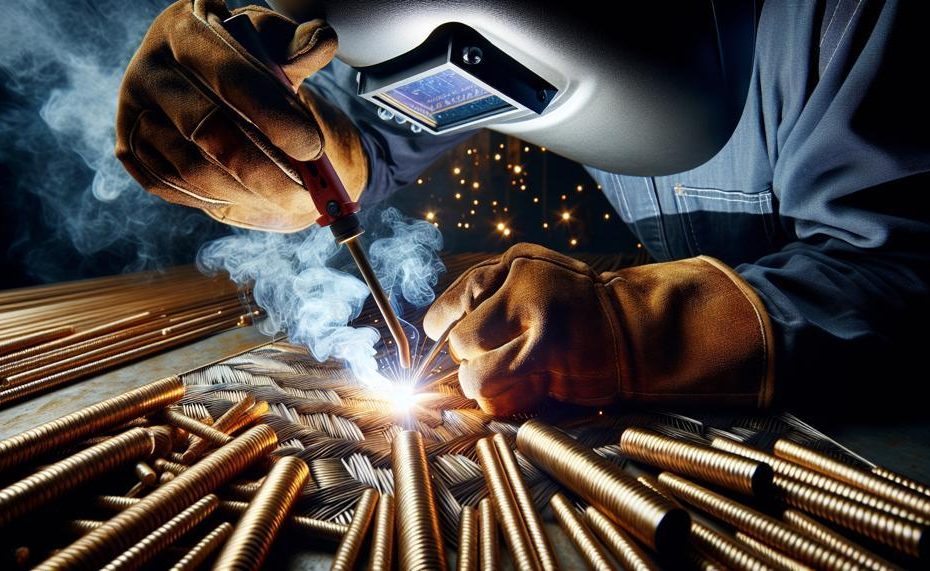Are you a welding enthusiast eager to expand your skill set? Or are you a DIYer in need of joining two different metals together for your latest project? If so, the question of whether brass can be mig-welded to steel may have crossed your mind.
While it may seem like a simple task, achieving a strong and durable bond between these two metals requires specific techniques and considerations.
In this blog post, we’ll delve into the world of welding brass to steel and cover everything you need to know about this process. From understanding the basics of these two metals to exploring the various methods of welding them together, we’ve got you covered.
So, put on your safety gear and get ready for an informative and exciting journey.
By the end of this post, you’ll have a better understanding of how to successfully weld brass to steel and be equipped with the knowledge to take on any welding project with confidence.
Let’s fire up those torches.
- Discovering the Fundamentals of Welding Brass and Steel
- Emphasizing the importance of proper technique
- Exploring different methods for successfully welding brass to steel
Contents
What is MIG Welding?
MIG welding, also known as Gas Metal Arc Welding (GMAW), is a welding process that involves melting the base metal and filler metal using an electric arc. This arc is created between a wire electrode and the base material, forming a pool of molten metal that solidifies to create a strong bond between the two materials.
The following are the steps involved in MIG welding:
- Preparing the materials: Before starting the welding process, it is imperative to thoroughly clean and prepare the materials to be welded. This includes removing any rust, dirt, or other contaminants from the surfaces to ensure a strong and clean weld.
- Setting up the equipment: Properly setting up the MIG welding machine is crucial for a successful weld. This includes adjusting the voltage, wire feed speed, and gas flow rate to achieve the desired results.
- Positioning the welding gun: To ensure a smooth and even weld, the welding gun should be held at a consistent distance and angle from the workpiece.
- Starting the arc: Once all the settings are in place, the welding gun is triggered to start the electric arc. This heats up the wire electrode and melts it, creating a weld pool.
- Feeding the wire electrode: As the welding gun moves along the joint, it continuously feeds the wire electrode into the weld pool. This provides a constant supply of filler metal to strengthen and reinforce the bond between the base materials.
- Adding shielding gas: The welding gun also releases a shielding gas, typically argon or a mix of argon and carbon dioxide, to protect the weld pool from contamination by atmospheric gases.
- Finishing the weld: As the welding gun reaches the end of the joint, it is slowly moved away from the workpiece while still feeding wire and releasing shielding gas. This creates a smooth and clean finish.
- MIG welding relies on three crucial elements: heat, filler metal, and shielding gas. This process is relatively simple and efficient, allowing for fast and strong welds on various materials. However, it requires proper training and safety precautions to ensure a successful and safe weld.
Tips for MIG Welding
MIG welding brass to steel can be a challenging task, but with the right techniques and precautions, it can be accomplished successfully. Below are some helpful tips for MIG welding brass to steel:
- Choose the correct filler metal. : When welding brass to steel, it is crucial to use a filler metal that is suitable for both materials. In this case, a brass filler rod or wire is recommended, as it will create a strong bond between the two metals.
- Adjust your settings: Brass has a lower melting point than steel, so it’s important to adjust your MIG welder settings accordingly. Lowering the voltage and wire feed speed will prevent overheating and ensure a smooth weld.
- Use the right shielding gas: When welding brass to steel, a shielding gas with a high percentage of argon or pure argon should be used. This will protect the weld from oxidation and produce a clean, robust joint.
- Clean and prepare the materials: Before starting the welding process, ensure that both the brass and steel surfaces are clean and free of any dirt, oil, or rust. This will result in a better weld and reduce the risk of contamination.
- Practice proper technique: Maintaining a consistent distance, angle, and speed while moving the welding gun is crucial for a successful weld. It’s also essential to start welding at an end joint and gradually work towards the center.
- Wear protective gear: As with any welding process, it’s vital to wear protective gear such as gloves, a helmet, and an apron to prevent injuries from sparks and heat.
- Consider ventilation: Welding brass produces fumes that can be hazardous if inhaled. Ensure that you are working in a well-ventilated area or use personal protective equipment such as a respirator.
- Test your weld: After completing the weld, test its strength by attempting to break it with pliers. If it holds, then you have successfully welded brass to steel.
Materials Used in MIG Welding

MIG welding is a popular welding method that utilizes various materials, such as steel, stainless steel, aluminum, and brass. Each of these materials possesses unique properties that make them suitable for different applications.
Steel, known for its strength and durability, is a commonly used material in MIG welding because of its affordability and easy accessibility. Low-carbon steels, like A36 steel, are often used due to their good ductility and ability to be welded without cracking.
Stainless steel, containing at least 10.5% chromium, offers excellent resistance to corrosion. It is a preferred material in MIG welding for its strength and weldability. However, not all grades of stainless steel are suitable for welding due to varying carbon levels that can affect weldability.
Aluminum, known for its lightweight nature and high strength-to-weight ratio, is also commonly used in MIG welding. However, it poses a challenge due to its low melting point and tendency to form an oxide layer when exposed to air.
Brass, a metal alloy made up of copper and zinc, is another common material in MIG welding due to its good electrical and thermal conductivity. However, it requires precise heat control as it is prone to cracking.
How to Weld Brass
When welding brass to steel using the MIG welding technique, there are several crucial steps to follow in order to ensure a strong and clean weld.
Prepare the Materials:
Before starting the welding process, it is crucial to thoroughly clean and prepare the materials. Any dirt, oil, or debris on the surface can greatly affect the quality of the weld. Use a degreasing agent or sandpaper to remove any contaminants from both the brass and steel surfaces.
Select the Correct Filler Metal:
When welding brass to steel, it is essential to choose a filler metal that is compatible with both materials.
A copper-zinc alloy, such as 60/40 brass, is an ideal option for this type of welding.
Adjust Welding Settings:
It is recommended to use lower voltage and wire speed when welding brass compared to steel.
This is because brass has a lower melting point and can easily overheat if excessive heat is applied.
Apply a Brazing Welding Flux:
Before welding, it is beneficial to apply a brazing welding flux to the joint area. This will help prevent oxidation and improve the strength of the weld.
This step is especially crucial when welding brass to steel since these two materials have different melting points and can create an unstable joint without proper flux.
Use Proper Safety Gear:
Welding can be hazardous, so always remember to wear protective gear such as gloves, goggles, and an apron.
Brass contains copper, which can release harmful fumes when heated, so make sure to work in a well-ventilated area.
Maintain Consistent Distance and Angle:
To achieve a clean and robust weld, it is vital to maintain a consistent distance between the welding gun and the joint, as well as a consistent angle.
This will ensure that the weld is evenly distributed and has adequate penetration.
Finish with Post-Weld Cleaning:
After completing the weld, it is crucial to clean the joint area with a wire brush to remove any remaining flux or debris.
This will help prevent any corrosion or weak spots in the weld.
Advantages and Disadvantages of MIG Welding

When it comes to welding, MIG welding is a top choice for many welders due to its versatility, high speed, ease of learning, and cost-effectiveness. However, there are a few downsides to using MIG welding that should be considered.
Advantages
On the positive side, one of the greatest advantages of MIG welding is its versatility. This method can be used on a variety of materials, such as steel, stainless steel, and aluminum. This makes it a popular choice for many professionals in the industry.
Another advantage of MIG welding is its high welding speed. This means that projects can be completed faster, making it a more efficient option for those with tight deadlines. Additionally, MIG welding is easier to learn compared to other types of welding, making it a great option for beginners.
In terms of cost-effectiveness, MIG welding is often more affordable than other types of welding. This is because it requires less expensive equipment and consumables. It also produces minimal clean-up after the welding process is complete.
Disadvantages
MIG welding does have some disadvantages that should be taken into consideration. One major downside is its lack of precision. This method can result in a less precise weld compared to other types of welding. Additionally, MIG welding is not very portable and requires clean surfaces for optimal results.
Finally, safety is always a top priority when it comes to any type of welding. With MIG welding, clean surfaces are essential for safety and to prevent any potential hazards. It’s important to take proper safety precautions when using this method to ensure a safe working environment.
Conclusion
In conclusion, welding brass to steel through the MIG welding technique requires careful preparation, proper materials and settings, and a focus on safety and technique.
By following these guidelines, you can achieve a robust and polished weld when joining these two metals. MIG welding offers numerous benefits, such as versatility, speed, ease of learning, and cost-effectiveness.
However, it also has its drawbacks to consider, including a lack of precision and portability. It is crucial to have a thorough understanding of both brass and steel before attempting to weld them together.
With the right knowledge and precautions in place, you can confidently tackle any welding project involving brass and steel.





